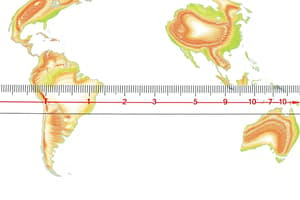Podcast
Questions and Answers
What does the Richter scale measure?
What does the Richter scale measure?
- The amount of ground shaking and energy released (correct)
- The amount of damage to buildings
- The length of the earthquake
- The number of people affected by an earthquake
Who invented the Richter scale?
Who invented the Richter scale?
- Charles Richter (correct)
- Beno Gutenberg
- Marie Curie
- Albert Einstein
What tool is used to detect and record earthquakes for the Richter scale?
What tool is used to detect and record earthquakes for the Richter scale?
- Telescope
- Seismograph (correct)
- Barometer
- Microscope
Each whole number increase on the Richter scale represents approximately how much more energy released?
Each whole number increase on the Richter scale represents approximately how much more energy released?
For what magnitude of earthquakes is the Richter scale most effective?
For what magnitude of earthquakes is the Richter scale most effective?
Flashcards
What is the Richter Scale?
What is the Richter Scale?
A system used to measure the strength or magnitude of an earthquake based on ground shaking and energy released.
Who are seismologists?
Who are seismologists?
Scientists that study earthquakes.
What is a seismograph?
What is a seismograph?
An instrument that detects and records earthquakes.
How does the Richter Scale work?
How does the Richter Scale work?
Signup and view all the flashcards
What is the Moment Magnitude Scale?
What is the Moment Magnitude Scale?
Signup and view all the flashcards
Study Notes
- The Richter scale measures the magnitude of an earthquake based on ground shaking and energy released.
- It is not a measure of destruction caused.
- Seismologist Charles Richter invented it in 1935.
- Richter was inspired to study seismology at the California Institute of Technology.
- Richter was an assistant to seismologist Beno Gutenburg.
- Initially, it was for Southern California earthquakes, but is now used worldwide.
Importance and Uses
- The Richter scale is a standard for classifying earthquake magnitude.
- It is most effective for moderate-sized earthquakes, which are magnitudes 3-7.
How Earthquakes are Measured
- The scale ranges from 1 to 10, but includes measurements in fractions.
- It uses a seismograph to detect and record earthquakes, measuring seismic activity.
- Seismic activity is the movement of ground caused by rocks breaking underground.
- The seismograph calibrates the largest seismic wave and calculates the logarithm of its amplitude to determine magnitude.
- Accuracy is affected by proximity and the type of seismograph used.
- It is less accurate for earthquakes of magnitude 6.5 and higher.
- Each magnitude increase represents a 10-fold increase in ground shaking intensity.
- Each unit increase signifies about a 32-fold increase in energy released.
- An earthquake increasing from magnitude 4 to 8 increases in intensity by 1,048,576 times.
Moment Magnitude Scale
- The moment magnitude scale was developed in 1979 to complement the Richter scale.
- It can accurately measure highly destructive earthquakes with a magnitude of over 8.
- The Richter scale is more accurate for small to moderate earthquakes.
- The moment magnitude scale uses the seismic moment to determine its overall magnitude.
- Seismic moment is the force required to move a fault multiplied by the fault's displacement across the area.
Studying That Suits You
Use AI to generate personalized quizzes and flashcards to suit your learning preferences.





